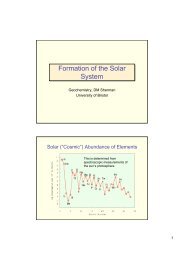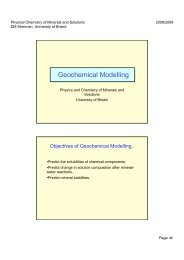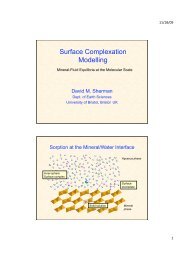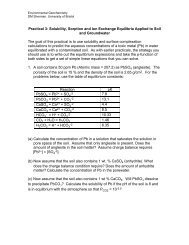Lecture Notes (PDF) - University of Bristol
Lecture Notes (PDF) - University of Bristol
Lecture Notes (PDF) - University of Bristol
Create successful ePaper yourself
Turn your PDF publications into a flip-book with our unique Google optimized e-Paper software.
Chemistry for Earth Scientists<br />
DM Sherman, <strong>University</strong> <strong>of</strong> <strong>Bristol</strong> <br />
2012/2013<br />
Ions and Ionic Compounds<br />
Chemistry for Earth Scientists,<br />
DM Sherman<br />
<strong>University</strong> <strong>of</strong> <strong>Bristol</strong><br />
Stable Electronic Configurations<br />
Atoms like to adopt closed-shell configurations. To do this, they<br />
may gain or lose electrons to become ions<br />
NaNa: 0 : open shell<br />
Na + Na : closed + : closed shell shell<br />
Page 1
Chemistry for Earth Scientists<br />
DM Sherman, <strong>University</strong> <strong>of</strong> <strong>Bristol</strong> <br />
2012/2013<br />
Stable Electronic Configurations (Cont.)<br />
The most stable ionization state <strong>of</strong> Si is the Si 4+ ion. The semiclosed<br />
shell Si 2+ ion does exist in interstellar gas, however.<br />
Si 0 : open shell<br />
Si 4+ : closed shell<br />
Stable Electronic Configurations (Cont.)<br />
Iron cannot adopt a closed-shell configuration... <br />
Fe 0 : open shell<br />
Fe 3+ : open shell<br />
Page 2
Chemistry for Earth Scientists<br />
DM Sherman, <strong>University</strong> <strong>of</strong> <strong>Bristol</strong> <br />
2012/2013<br />
Electronegativity<br />
Solar (“Cosmic”) Abundance <strong>of</strong> Elements!<br />
The most abundant element in the rocky planets is<br />
oxygen which is (almost) the most electronegative<br />
element.<br />
Page 3
Chemistry for Earth Scientists<br />
DM Sherman, <strong>University</strong> <strong>of</strong> <strong>Bristol</strong> <br />
2012/2013<br />
Ions and Electronic Configurations!<br />
Whether an atom will gain electrons<br />
to become an anion or lose<br />
electrons to become a cation<br />
depends on its electronegativity<br />
relative to other atoms.<br />
Mg + O → Mg 2+ + O 2-<br />
Atoms with high electronegativity<br />
tend to become anions. More<br />
precisely, if two neutral atoms come<br />
together, the more electronegative<br />
atom will receive electrons and<br />
become the anion.<br />
Stable Ions and Oxidation states<br />
The full ionic charge is only<br />
realized in completely ionic<br />
compounds. Otherwise it is only<br />
the formal oxidation state.<br />
Page 4
Chemistry for Earth Scientists<br />
DM Sherman, <strong>University</strong> <strong>of</strong> <strong>Bristol</strong> <br />
2012/2013<br />
Attraction between ions:<br />
The force between two point<br />
charges a and b is<br />
F =<br />
q a q b<br />
4πε 0<br />
r 2<br />
€<br />
But ions are not point charges;<br />
as they get closer, the nuclei<br />
repel each other as do the<br />
electron “clouds” on adjacent<br />
ions.<br />
Ionic Bonds<br />
• Formed between atoms <strong>of</strong> very different<br />
electronegativity.<br />
• The less electronegative atom completely donates<br />
one or more electron to the more electronegative<br />
atom. The resulting ions are held together by<br />
electrostatic attraction.<br />
• Most important for<br />
bonding between O<br />
and Mg, Ca, Si, Al, Na,<br />
K.<br />
• Hence, the primary<br />
bonding type in silicate<br />
and oxide minerals.<br />
Page 5
Chemistry for Earth Scientists<br />
DM Sherman, <strong>University</strong> <strong>of</strong> <strong>Bristol</strong> <br />
2012/2013<br />
Ionic Radii<br />
• An ion with a closed-shell configuration will have a spherical<br />
electron distribution.<br />
• To a first<br />
approximation, the<br />
ionic radius will be<br />
constant.<br />
• A better approximation<br />
gives different radii for<br />
each coordination<br />
number.<br />
• The radius <strong>of</strong> an ion<br />
can be a very useful<br />
predictor <strong>of</strong> an ion’s<br />
geochemical behaviour.<br />
Ionic Radii and Solid Solutions<br />
Ions with similar radii can substitute for each other (even if charges<br />
are different). <br />
Example: the amphibole hornblende<br />
(Na,Ca) 2 (Mg,Fe,Al) 5 [(Al,Si) 4 O 11 ] 2 (OH) 2<br />
has a complex composition due to solid<br />
solutions.<br />
Page 6
Chemistry for Earth Scientists<br />
DM Sherman, <strong>University</strong> <strong>of</strong> <strong>Bristol</strong> <br />
2012/2013<br />
Pauling’s Rules for Ionic Structures!<br />
Rule 1: The coordination number <strong>of</strong> a<br />
cation A by an anion B will be<br />
determined by the radius ratio <strong>of</strong><br />
the ions A and B:<br />
Radius Ratio CN Examples*<br />
R A /R B < 0.16 3 C 4+<br />
0.16 > R A /R B < 0.41 4 Si 4+ , Al 3+<br />
0.41 > R A /R B < 0.73 6 Fe 2+ , Mg 2+<br />
0.73 > R A /R B < 1.0 8 Ca 2+ , Na+<br />
1.0 > R A /R B 12 K +<br />
*when coordinated by O 2- .<br />
Pauling’s Rules for Ionic Structures (cont.)<br />
Rule 2: For an anion to be<br />
stable, the sum <strong>of</strong> the<br />
strengths* <strong>of</strong> the electrostatic<br />
bonds that reach an anion<br />
from its coordination <strong>of</strong> cations<br />
will equal the charge on the<br />
anion. This is the<br />
electrostatic valency<br />
principle.<br />
(*The “Pauling bond strength” or “Bond Valence” that a cation gives to<br />
an anion is the cation charge/coordination number).<br />
Page 7
Chemistry for Earth Scientists<br />
DM Sherman, <strong>University</strong> <strong>of</strong> <strong>Bristol</strong> <br />
2012/2013<br />
Volatiles in the Mantle (?): Prediction from<br />
Paulings 2 nd Rule<br />
Wadsleyite (β-Mg 2 SiO 4 )<br />
Replace Mg with 2H +<br />
• Octahedral (yellow) sites for Mg.<br />
• Si tetrahedra in corner-shared pairs<br />
• One oxygen has a ∑PBS <strong>of</strong> only 4/3.<br />
Pauling’s Rules for Ionic Structures<br />
Rule 3: The sharing <strong>of</strong> edges and faces by<br />
coordination polyhedra decreases the stability <strong>of</strong> a<br />
structure.<br />
Edge-sharing<br />
Corner-sharing<br />
Face-sharing<br />
Page 8
Chemistry for Earth Scientists<br />
DM Sherman, <strong>University</strong> <strong>of</strong> <strong>Bristol</strong> <br />
2012/2013<br />
Pauling’s Rules for Ionic Structures (cont.)<br />
Rule 3: The sharing <strong>of</strong> edges and faces by coordination polyhedra<br />
decreases the stability <strong>of</strong> a structure.<br />
Anatase<br />
Rutile<br />
There are two polymorphs <strong>of</strong> TiO 2 . Rutile is more stable (by 6 kJ/mole)<br />
than anatase because there is less edge-sharing in the structure.<br />
Breakdown <strong>of</strong> Pauling’s Rules<br />
Pauling’s rules will fail when bonds are not ionic. Sulfide minerals<br />
tend to have covalent bonds with S. Metallic bonding is also found is<br />
metals and many sulfides.<br />
Mackinawite (FeS)<br />
Triolite (FeS)<br />
Page 9
Chemistry for Earth Scientists<br />
DM Sherman, <strong>University</strong> <strong>of</strong> <strong>Bristol</strong> <br />
2012/2013<br />
Breakdown <strong>of</strong> Pauling’s Rules<br />
At high pressure, Pauling’s first rule break down as<br />
cations adopt high coordination numbers.<br />
Si in 4-fold<br />
coordination<br />
Olivine Mg 2 SiO4<br />
Mg in 6-fold<br />
coordination<br />
Si in 6-fold<br />
coordination<br />
MgSiO 3 Perovskite<br />
Mg in 12-fold<br />
coordination<br />
Chemical bonding: ionic vs. covalent<br />
When electrons are completely transferred between<br />
atoms to yield cations and anions, the atoms will be<br />
held together by ionic bonds.<br />
If atoms have similar<br />
electronegativities, they<br />
adopt closed-shell<br />
configurations by sharing<br />
electrons with each other;<br />
the atoms are held together<br />
by covalent bonds.<br />
Page 10
Chemistry for Earth Scientists<br />
DM Sherman, <strong>University</strong> <strong>of</strong> <strong>Bristol</strong> <br />
2012/2013<br />
Ionic Potential and Ion Hydration!<br />
Large cations with low<br />
charge will be weakly<br />
hydrated.<br />
Small cations with<br />
high charge will form<br />
oxyanions (or<br />
oxycations).<br />
Summary<br />
Be able to:<br />
work out the electronic configurations via the<br />
Pauli exclusion principle.<br />
predict the stable ions in geochemistry (e.g.,<br />
Mg +2 , Si +4 , Al +3 ..).<br />
• Ionic bonds form between atoms <strong>of</strong> different<br />
electronegativity.<br />
• The concept <strong>of</strong> ionic radius is a useful picture for<br />
geochemistry. Ions with similar radii can <strong>of</strong>ten<br />
substitute for each other.<br />
• Pauling’s rules give a predictive model for ionic<br />
structures.<br />
Page 11
















